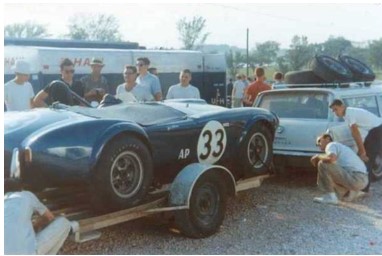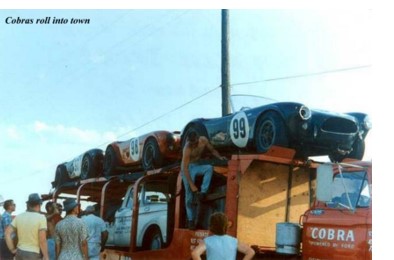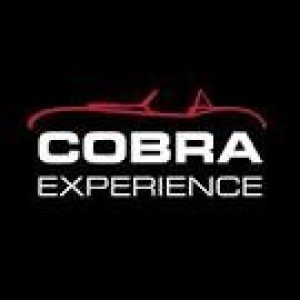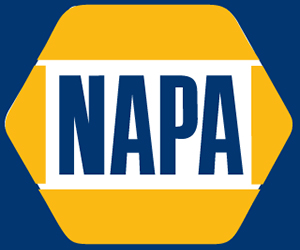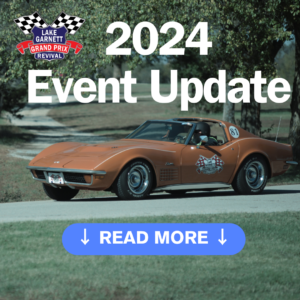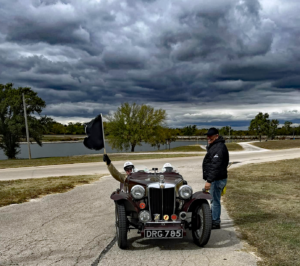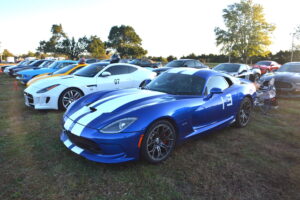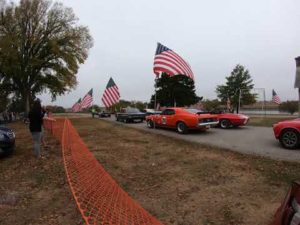Contributed by Brooks Laudin from the Cobra Experience
Author at the Cobra Experience
Brooks Laudin

They say a picture is worth a 1000 words. Some pictures are worth more than that, including this one (good for 2400 words) which was brought to our attention by a recent visitor to The Cobra Experience. Dan Haugh is from Kansas, was at this race as a 10-year old, and came out of his seat when this image from the 1963 race at Lake Garnett crossed the screen during our in-house movie at the museum. Like others before him, he suggested there was more to the story behind a simple image, and boy howdy, was he right.
Now Dan is not our average visitor. Born and bred in Lawrence, Kansas with a mechanical engineering degree from the University of Kansas, Dan makes his money from contract parts and services for military, commercial and general aviation; and spends it chasing speed records at Bonneville. He has made seven speed records since 2016 and still owns two at about 170 mph …. in a 1981, 2.0 liter Saab, running in the Classic Production Supercharged 4.0 liter class! The engine is blown and runs on altered fuel, but the body is stock and anything but an aero-dynamic wonder.
True to the history of land speed racing (and his vocation), Dan “names” his car for each effort with the tail number off a famous military plane; in 2020 it was “6259” which was the tail number off the B-29 which received the prototype “Project Silverplate” modifications needed to accommodate the 10,000 pound nuclear bombs destined to be dropped on Japan. The plane was built in Boeing’s Wichita KS. plant, Dan’s first employer.
North Lake Park in Garnett, Kansas, (about 75-miles SSW of Kansas City) was built by the Civilian Conservation Corps between 1934 and 1936 to encompass about 300-acres, hundreds of planted trees and a man-made 48-acre lake inside a 2.85 mile circular road that allowed access to the park.

The road came to fame in its own right when the Kansas City Region of the SCCA, which was founded in 1952, hosted a series of sports car races on the access road each July, starting in 1959. This was a natural and true-road course and not for the faint of heart; maybe 24’ wide with stone walls, trees, ups and downs, twists and turns. Keep in mind the road was built to get Andy and Opie in a Model A to the parking lot somewhere by the lake to go fishing.
The SCCA Kansas City Region had long been aware of this road but it was not until late 1959 that three guys out of the Region; Bill Ong, then Regional Executive; Dale Duncan, then Race Chairman; and Hal Stipe, then Chief Steward contacted several members that lived in Garnett about hosting a race in the park.
Far sighted city officials took the bit in their mouth and formed a racing association, put up $3,500 and tasked Don Stith, a local investment advisor, with making it happen. Bill Ong was a former barnstormer, noted aviator (he held commercial pilot certificate No. 1904), champion air racer and part time automobile racer. Dale Duncan was Masten Gregory’s brother-in-law and noted sports car racer in the 50’s. To wit, Duncan was selected by Jim Kimberly in 1954 to race in Argentina with Carroll Shelby, in Roy Cherryhomes’ Cad-Allard. Infamously, when the Allard’s carbs caught fire during a pit stop in Argentina, and absent a fire extinguisher, the quick thinking Duncan extinguished the flames by urinating on the engine.
Some 25 entries and about 15,000 people attended the First Annual Lake Garnett Grand Prix on July 5, 1959. By 1963 the race had grown to SCCA National status (the only one that year west of the Mississippi) and the Fifth Annual Lake Garnett Grand Prix presented a full card of class races between 350 entrants in 140 cars, over two days on July 6 and 7, 1963.
Some further context for the Lake Garnett races is in order; 1963 dawned for Shelby American with Ford still not sure what they had going on with “that Texan”. His Cobras had finally finished two races at Nassau in December, but Shelby’s factory driver had left to drive a Corvette for 1963. Despite the disappointment, enough money was found to hire drivers Dave MacDonald and Ken Miles in January followed in April by Bob Holbert. The factory team was set and their goal would be to chase the just-introduced United States Road Racing (USRRC) Championship which had both a Driver and Manufacturer Championship on offer.
Following Sebring, in late March, the first of the “old” 1962 260 Cobra race cars (CSX 2026) was sold to noted Corvette racer Bob Johnson of Columbus Ohio, with the expectation that he would be “force multiplier” and increase the exposure for Shelby American while chasing the SCCA “A” Production class in the Midwest.
And that Johnson did with a vengeance, starting in April 1963 with three wins in eight races over the next few weeks leading up to the USRRC Manufacturers race at Watkins Glen on Sunday afternoon June 30, 1963. There, the three factory drivers, MacDonald, Miles and Holbert, were in the current “Sebring” 289 cars; respectively CSX 2128, CSX 2129 and CSX 2127 while Bob Johnson, Bob Brown and Eppie Weitzes respectively were in CSX 2026, CSX 2043 and CSX 2002.
Eleven cars were entered in the USRRC GT Class, six Cobras, three Corvettes and two Ferraris. The race was set for 150 miles or 66 laps. First out of the race was Eppie Wietzes in CSX 2002 with a blown clutch on lap two, followed a few minutes later by Bob Holbert in CSX 2127 with front suspension issues. Bob Johnson went on to win the race, in last year’s race car, now sporting a 289 engine that had already seen 300 race miles under Dave MacDonald and Fireball Roberts at Sebring some weeks before (CSX 2026 had retired that day with a fried differential). Holbert salvaged his day with a win in the last race of the day, the USRRC Grand Prix, where he piloted a Porsche RS 61 home 1st OA. Ken Miles, in an iron-man performance, stayed in CSX 2129 and finished a credible 3rd OA, one lap adrift, in the Watkins Glen finale.
The next target for the factory team were the USRRC races in Kent, WA., three weeks later on July 20-21. Meanwhile Bob Johnson had scheduled himself into the Lake Garnett SCCA races on July 6-7. More than one version of the events has it that Grady Davis, a Gulf Oil executive with deep ties to GM, determined the Lake Garnett races would be a fine opportunity for his team of new Corvette Stingrays to gang up on a lone Cobra at a national event.
Shelby got wind of the plan, looked at the map, and determined that he would take his time getting back out west. So the Shelby American transporter, which was beginning to develop and ominous presence on the race circuit, rolled into Garnett, KS. and unloaded. At this point the team was traveling with a fake tombstone that read “Here Lies the Sting Rays” which Al Dowd set up on a “grave” in the infield before the races went off; the point being made despite the weird alliteration.
Saturday, July 6, dawned hot and muggy, and the teams went through their pre-race rituals. A crowd of about 15,000 watched the practice, qualifying and the one race that afternoon, the H-Production class. For the record, general admission, including parking, was $1.50 on Saturday for qualifying, and $2.00 on race day.
Keeping in mind Garnett, KS., was (and remains) a town of about 3,000 souls, anything like a race crowd was going to be handful on any level for the authorities. Saturday night proved the point when the Garnett police asked the two bars and one club downtown to stop selling beer at about 11:00PM. That led to some fireworks and beer bottles being aimed at the grossly out-manned police force of five officers, and after a few arrests, soon a crowd of about 1,500 drunken youths started a full blown riot. Unlike the politically motivated riots of today, this was more a garden variety riot; the poor cops and fire department in a small town trying to keep a lid on a mob of drunken kids.
Long story short, by 1:30AM the governor had ordered the National Guard mobilized to quell the riot. Unfortunately a police captain from a neighboring town died of a heart attack in the melee and the Garnett locals were dismayed that the weekend racing event had been permanently marred and might never happen again. The racers and their crews were not happy either; many of the crews spent the night in the paddock to protect their cars. Not that they missed much in the way of a place to sleep; most of the crews were put up with locals in their houses. Shelby reportedly left a pair of silver cuff links engraved with “CSX” with his host.
Sunday morning July 7 saw some 70,000 spectators make their way to the track, in large part lured by the up-coming Cobra vs. Stingray battle. What a juxtaposition, the Cobra birthed with pretty much zero engineering, and expenses of maybe $40,000, in Dean Moon’s cramped shop in Santa Fe Springs vs. the product of untold millions spent by GM in Detroit on the latest version of their Corvette.
The A-B-C Production race featured four Cobras; Dave MacDonald in CSX 2128, Ken Miles in CSX 2129, Bob Johnson in CSX 2026 and independent Robert E. Lee Hayes in CSX 2017. Bob Holbert’s car, CSX 2127, was left on the transporter as he was busy elsewhere. Davis’ Stingray crew included Dr. Dick Thompson, Don Yenko and Grady Davis himself, a competent driver in his own right. Davis brought four Corvettes, two light-weight A-Production Z06 Stingrays and an older B-Production Corvette (Yenko) for the production race, plus a Grand Sport (#004) for the modified race later in the day. Fourteen cars towed the line for the 45-minute A-B-C Production race, rounded out by Lew Spencer in a Morgan and a couple of AC Bristols, plus a junk-special or two.
The picture at the top of this article was taken about a mile into the race with Dave MacDonald out to the right and Johnson leading Miles. Although these three swapped the lead during the race, Bob Johnson took the checkered for the second week in a row (seems likely on team orders as the A Production race was Johnson’s turf), followed by MacDonald, Miles and Thompson adrift by 80-seconds in the white Z06. The Cobras had lapped the entire field with the exception of Thompson. Bob Hayes in CSX 2017 had retired with a broken gear shift lever on lap four.

The main attraction, the 45-minute 1963 Lake Garnett Grand Prix race, would see about 30 modified cars on the line some two hours later. The three factory team cars had been delivered with electric differential coolers which had been disconnected at the toggle switch for the SCCA A Production race. Ken Miles, true to form, wanted a go at the Grand Sport in the Modified race so his car had the differential cooler reconnected to qualify as a “modified” Cobra, and he placed it on the pole. Dale Duncan, now of the SCCA Dallas Region and Shelby’s co-driver and part-time fireman in Argentina nine years earlier, was the starter for the Grand Prix.
At the flag drop Miles and (eventually) Dick Thompson in the Grand Sport tore away from the field, but the much anticipated duel was not to last long. Thompson, who never headed Miles, went out on lap eleven with a blown engine leaving Miles to cruise to the finish well ahead of Harry Heuer in a Chaparral and Jack Hinkle in a Cooper Monaco. Aside from the win, Miles walked away with the Top Driver’s Award for the weekend.
The most exciting moment occurred on the third lap when Harvey Woodward launched his Elva Mk VI into the lake. His brakes failed as he ran up on traffic at the chicane at the end of the long straight and rather than plow into the cars ahead of him, he veered right into the lake. The race was red flagged for 10 minutes, or so, while the authorities recovered Woodward, wet, shaken, but unharmed from the lake; his car was fished out of 40’ of water after the race. Woodward had won the inaugural Grand Prix in 1959 in an AC Bristol.
The Shelby American factory team would not appear at Lake Garnett again. Two independent Cobras were entered in 1964, but Graham Shaw wrecked his car (CSX 2409) in Saturday practice and Robert E. Lee Hayes wrecked his (CSX 2017) in Sunday practice.
That was it, the transporter was re-loaded, another notch was cut into Shelby’s belt and the team headed west. The Lake Garnett Grand Prix ran each July from 1959 to 1972, when crowd control issues and track safety finally killed the race. In 2013 The Lake Garnett Grand Prix Revival brought historic racing back to the track, now headed into its 11th year this October.
POSTSCRIPT: 1963 was a great year for Shelby American and Ford. Shelby American went on to win the USRRC Manufacturers Championship in 1963. Bob Holbert won the USRRC Drivers Championship after splitting time between modified and GT cars for Shelby American. Ken Miles finished second on points. Bob Johnson won the SCCA A Production Championship with CSX 2026, last year’s race car. And Dave Macdonald won the inaugural USRRC Pro Division in the King Cobra. Race wins sell cars and Ford was (and frankly, remains) well rewarded for its support of Shelby American in 1963.

A tip of the hat to Tracy Modlin, President of the Lake Garnett Grand Prix Reunion and Mike McGinley, just-past SCCA Kansas City Regional Executive, for help filling in the blanks. Thank you!

